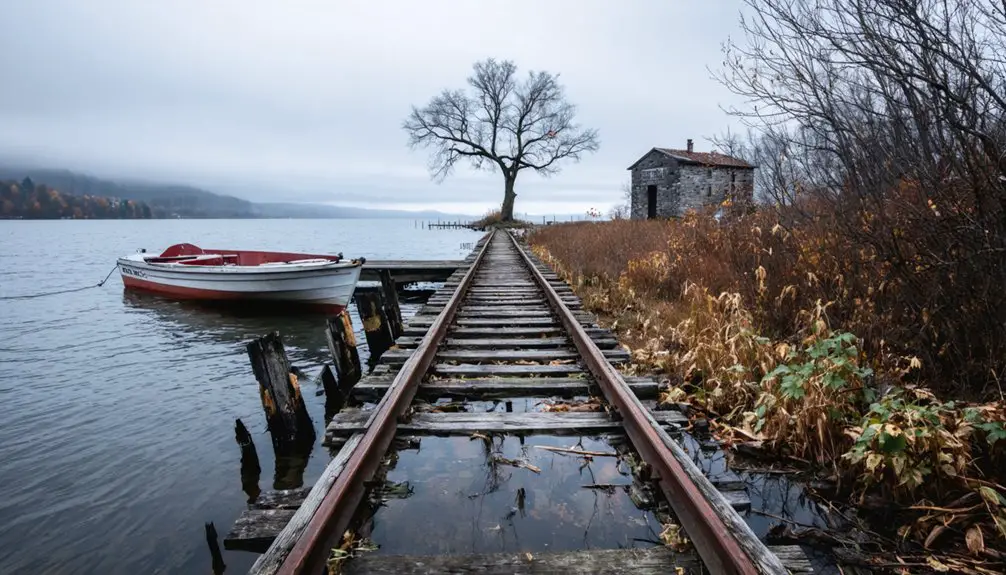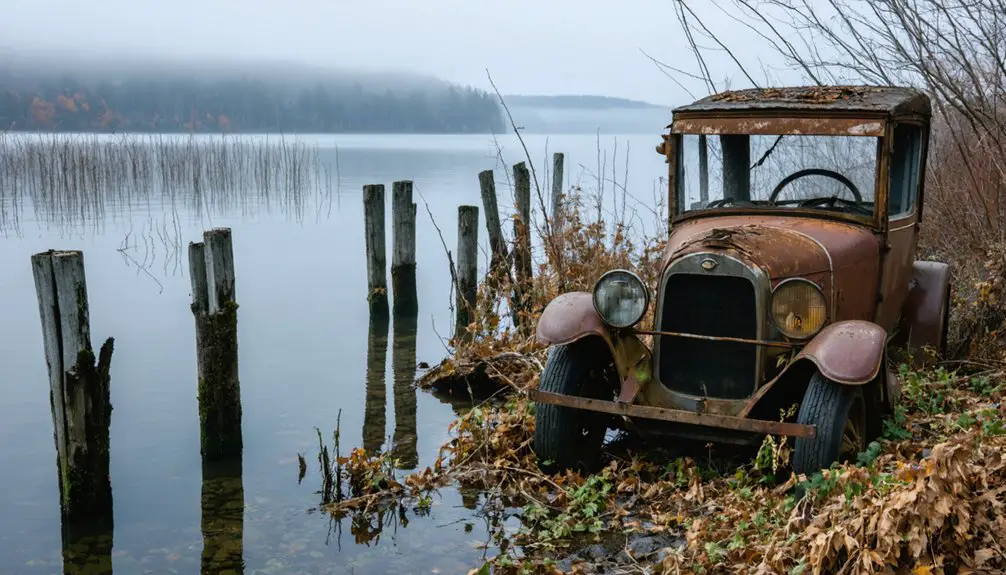You’ll find Cedar Beach’s ruins along Lake Champlain, where John Bagley founded a lakeside settlement in 1872. The community began with the “Jolly Club,” twelve gentlemen who invested $200 to build the first cottage. By 1883, it had evolved into the Cedar Beach Association, with families sharing resources in simple cabins and tents. Though once vibrant with communal buildings, ferry docks, and ethnic neighborhoods, Cedar Beach’s isolation and fragmented infrastructure led to its eventual decline. The ghostly remains hold centuries of stories waiting to be uncovered.
Key Takeaways
- Cedar Beach was founded in 1872 along Lake Champlain’s shoreline by John Bagley and grew into a thriving lakeside community.
- The community’s decline began in the 1920s when road development isolated residences and disrupted traditional social gathering patterns.
- Infrastructure deteriorated over time, with remnants including stone foundations, weathered power poles, and abandoned communal buildings.
- Limited road access and harsh weather conditions contributed to the area’s transformation from vibrant community to scattered, disconnected properties.
- The ghost town contains historical structures built with materials from Fort Montgomery ruins and traces of ethnic immigrant neighborhoods.
The Rise of the Jolly Club Settlement
In the summer of 1872, Burlington merchant John Bagley established what would become the Jolly Club Settlement when he pitched a solitary tent along Cedar Beach‘s shoreline.
After several weeks of lakeside solitude, he convinced eleven other gentlemen to join his vision, forming the “Jolly Club” in 1873. Together, they invested $200 to construct their first group cottage, celebrating with a grand opening that drew 175 guests and featured the Queen City Band.
The Jolly Club’s first cottage marked a festive beginning, unifying twelve visionaries and drawing crowds to celebrate lakeside camaraderie.
Their initial cabins followed a simple yet practical design: twelve-by-sixteen-foot structures with one open room, an upstairs bunk room, and a sociable gable-front porch. The community steadily grew to include eighteen wood-frame cottages by 1885. The location proved strategic, as Lake Champlain had served as a vital waterway for military operations during three major wars.
This pioneering group formalized their communal identity as the Cedar Beach Association in 1883, setting the foundation for a thriving lakeside community.
Early Camp Life and Communal Spirit
The spirit of communal living took root as Cedar Beach’s early settlers adapted to their rustic environment. You’d find families dwelling in simple cabins and tents, embracing a lifestyle of shared resources that proved essential for survival.
Daily life centered around coordinated efforts – from communal cooking over open fires to collective gathering of firewood and tools. The nearby Lake Champlain shoreline stretched for miles, offering abundant fishing opportunities for the growing settlement. According to legend, British gold coins worth $75,000 were buried in the area after a 1773 attack.
As darkness fell, you’d witness the heart of camp life come alive. Residents would gather around flickering flames, sharing stories, songs, and local lore while planning the next day’s tasks.
Leaders emerged naturally, organizing work parties and mediating disputes. When winter’s harsh grip tightened or summer storms threatened, you’d see the community band together, pooling their knowledge of herbal remedies, weather patterns, and survival techniques to protect their lakeside haven.
Notable Structures and Infrastructure
You’ll find remnants of early communal buildings around Cedar Beach, including a one-room schoolhouse and boarding houses that once sheltered transient workers in the town’s industrial heyday.
Some structures featured stone and brick construction materials sourced from Fort Montgomery ruins, salvaged by local residents for various building projects in the area.
Electric trolleys operated through the town to transport lumber and charcoal to market during its productive years.
The settlement’s transportation network included gravel access roads following natural terrain and waterways, connecting the various industrial sites to facilitate movement of goods and workers.
Storage facilities and infrastructure remnants, like weathered power poles with glass insulators, reveal the town’s previous economic significance and its gradual shift into abandonment.
Early Communal Buildings
Cedar Beach’s early communal buildings reflected the practical needs of a bustling slate quarry town during the late 19th century.
You’ll find evidence of this communal living in the remaining stone foundations, where wooden frame houses once clustered near the quarry sites to house immigrant workers. These structures served as more than just shelter – they created distinct ethnic neighborhoods where Irish, Italian, and Slavic families maintained their cultural traditions.
The modest dwellings fostered tight-knit immigrant housing communities, a necessity in the company town model that dominated Cedar Beach’s early years. The site remains largely forgotten today, with limited public awareness of its historical significance.
While few of these original buildings have survived intact, their scattered stone foundations and partial walls still tell the story of a workforce that powered the slate industry’s boom years through their shared living spaces.
Transportation and Storage Facilities
Beyond the communal dwellings, an intricate network of transportation and storage infrastructure shaped Cedar Beach’s industrial landscape from 1875 to 1920.
You’ll find traces of extensive logging infrastructure, including dirt roads and rail spurs that once transported timber to lakeside mills. Like the Glastenbury logging region, severe erosion and flooding eventually led to infrastructure deterioration. The waterborne transport system featured docks and piers along Lake Champlain, enabling both legitimate commerce and clandestine rum-running operations during prohibition. Slate History Trail remnants indicate additional industrial activities that once contributed to the region’s economic vitality.
Near the railway junction, warehouses and lumber yards stored goods bound for distant markets, while grain barns dotted the agricultural periphery. Stone foundations and cellar holes still mark where these essential storage facilities once stood.
When floods and neglect eventually destroyed bridges and tracks, Cedar Beach’s critical transport arteries slowly faded into the wilderness.
Native History and Cultural Significance
Long before Cedar Beach became a ghost town, this contested region marked a volatile boundary between two powerful Native American nations – the Iroquois to the west and the Algonquins to the east.
The area’s indigenous heritage stretched back thousands of years, with the Abenaki people establishing deep cultural identity through their connection to the land they called dakinna. Archaeological evidence shows that indigenous peoples cultivated maize and beans at various lakeside locations.
- Rich ecosystems supported seasonal hunting, fishing, and gathering
- Archaeological evidence reveals ancient tools and soapstone cooking bowls
- Strategic waterways served as essential transportation corridors
- Winter yards in swamps provided protection from enemies
- Ceremonial council houses anchored community life
You’ll find that intense tribal conflicts eventually forced many communities to abandon permanent settlements along the lakeshore, though some groups maintained seasonal camps in concealed locations until European arrival intensified land disputes.
Transportation’s Impact on Community Evolution

You’ll find the early Cedar Beach community of the 1870s deeply intertwined with ferry life, as residents relied on steamboats and shared docks to connect with Burlington and other lake settlements.
By the 1920s, you’d witness a dramatic shift as automobiles revolutionized travel patterns, allowing year-round access but diminishing the communal nature of waterborne transport.
Your understanding of Cedar Beach’s decline becomes clearer when you consider how new road networks fragmented the once-tight community, transforming shared gathering spaces into private, isolated properties.
Ferry Life Before Automobiles
Before automobiles transformed transportation in the early 20th century, Cedar Beach’s community life revolved around its ferry systems, which began with simple sailboats before evolving into sophisticated horse-powered vessels.
Ferry technology advanced rapidly, with innovative designs featuring six horses powering massive paddle wheels through treadmills and horizontal discs.
- Ferries served as crucial community gathering points for local social events
- The Cedar Beach “Jolly Club” relied entirely on ferry transport for its 1873 grand opening
- Three horses on each side turned large discs connected to sidewheel paddles
- Steam-powered vessels replaced horse ferries in the 1850s
- Ferry docks became social hubs where camp communities shared facilities
You would’ve found these ferry services indispensable for everything from lumber transport to leisure activities, creating a vibrant waterfront culture that defined Cedar Beach’s early character.
Changing Travel Patterns 1920s
As automobiles emerged in the early 1920s, Cedar Beach’s transportation landscape underwent a dramatic transformation that would forever alter its community fabric.
You’d no longer see the familiar stream of horse-drawn carriages and ferry-dependent travelers along Lake Champlain’s shores.
The automobile influence reshaped how you’d access Cedar Beach entirely. While dirt roads initially limited travel independence, growing car ownership meant you could bypass traditional ferry routes and explore the lakeshore on your own terms.
This newfound mobility fragmented the once-cohesive community, as travelers no longer relied on communal transport networks. Truck transport gradually replaced water-based commercial shipping, while ferry operators struggled to adapt with diesel engines and modernization.
Road Access Fragments Community
While the advent of automobiles promised greater mobility, Cedar Beach’s fragmentary road development in the 1920s actually deepened the community’s isolation. You’d have witnessed a stark change as poor road connectivity fractured the once-tight community into disconnected pockets of residences and camps.
- Limited road access isolated homes from traditional gathering spots
- Shift from communal ferry docks to scattered car routes reduced social interaction
- Peninsula’s challenging geography prevented creation of unified road networks
- Harsh weather constantly degraded already fragmented road segments
- Declining year-round population meant less funding for road maintenance
The shift proved particularly devastating when winter storms rendered these incomplete roads impassable, leaving residents cut off from neighbors and essential services.
This infrastructure fragmentation ultimately accelerated Cedar Beach’s change from a vibrant lakeside community into scattered, disconnected properties.
Ghost Town Legends and Local Heritage
Since the early colonial period, Cedar Beach and its surrounding Lake Champlain region have accumulated a rich tapestry of legends and folklore.
You’ll find ghost stories of British soldiers who met their fate in a 1773 Indian attack, leaving behind $75,000 in gold coins that remain buried near the beach. Local treasure legends also tell of Captain Mallett, a Vermont pirate who established a tavern at what’s now Malletts Bay.
The area’s mystique deepens with Revolutionary War connections, including Benedict Arnold’s escape and mysterious cannon fire marks on the rocks.
On Isle La Motte’s islands, you’ll encounter eerie traditions like the practice of dropping a missing woman’s cloak to locate drowned bodies.
While forest fires have erased many physical traces, these enduring tales remain woven into the region’s cultural identity.
Frequently Asked Questions
What Happened to the Original Jolly Club Member Families Today?
You’ll find most descendants’ stories remain untraceable, though some original Jolly Club family legacies continue through modernized lakefront properties they’ve maintained, while others have sold and moved on entirely.
Are Any of the Original 1870S Fishing Camp Structures Still Standing?
You’ll find eighteen original structures from the 1870s fishing camp still standing today, with their core frames intact despite modifications. Many cabins retain their traditional layout, though they’ve been adapted over time.
What Was the Average Cost of a Cedar Beach Cabin in 1883?
You’d find cabin prices typically ranged from $100-$400 in 1883, reflecting the historical economy of rural Vermont, though exact Cedar Beach values aren’t documented in primary sources.
Did Any Famous Writers or Artists Spend Time at Cedar Beach?
You won’t find any documented literary influences or artistic retreats at this location. Despite extensive historical research, there’s no evidence of famous writers or artists having spent time there.
How Deep Was Mcneil’s Cove Where the First Camps Were Built?
You’ll find that McNeil’s Cove’s depth near the first camps wasn’t explicitly documented, but historical camp construction patterns suggest water depths of less than 20 feet for safe access and docking.
References
- https://obscurevermont.com/mysteries-and-legends-of-the-champlain-islands/
- https://www.thetravel.com/glastenbury-mountain-ghost-town-history-vermont/
- https://sah-archipedia.org/buildings/VT-01-CH62
- http://www.cedarislandvermont.com/the-islands-history/
- https://suncommunitynews.com/news/77169/when-west-castleton-vt-went-bust/
- https://www.wcvt.com/wp-content/uploads/2012/07/2000-history-cvt.pdf
- https://sah-archipedia.org/essays/VT-01-0004
- https://www.irs.gov/pub/irs-soi/eo_ca.csv
- https://urbanpostmortem.wordpress.com/2016/07/03/treasure/
- https://www.youtube.com/watch?v=ScW-H7A8yL8



